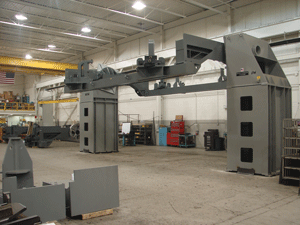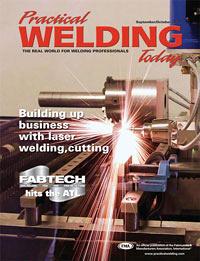Director of Marketing
- FMA
- The Fabricator
- FABTECH
- Canadian Metalworking
Categories
- Additive Manufacturing
- Aluminum Welding
- Arc Welding
- Assembly and Joining
- Automation and Robotics
- Bending and Forming
- Consumables
- Cutting and Weld Prep
- Electric Vehicles
- En Español
- Finishing
- Hydroforming
- Laser Cutting
- Laser Welding
- Machining
- Manufacturing Software
- Materials Handling
- Metals/Materials
- Oxyfuel Cutting
- Plasma Cutting
- Power Tools
- Punching and Other Holemaking
- Roll Forming
- Safety
- Sawing
- Shearing
- Shop Management
- Testing and Measuring
- Tube and Pipe Fabrication
- Tube and Pipe Production
- Waterjet Cutting
Industry Directory
Webcasts
Podcasts
FAB 40
Advertise
Subscribe
Account Login
Search
The small world of welding large fixtures
5 things you didn't know about large fixture making
- By Jeff Grivas
- September 13, 2010
- Article
- Arc Welding

Figure 1: This welding fixture for a part on a mining truck easily dwarfs the tool cabinets and racks on the shop floor.
Fixtures are critical to any welding job. If they don’t provide a tight fit-up, the final part won’t meet the specs set forth in the original print.
Fixtures are especially critical in very large welding jobs. The parts are larger, and the stakes are much greater. If the fixture does not meet the needs of the welding job when the arc is struck on the first day of production, the manufacturer is going to experience hours of unwanted downtime.
Large-fixture manufacturing is actually pretty unique. Gas metal arc welding (GMAW) is used most often to fabricate these fixtures, but that’s about the only similarity between the creation of small and large fixtures. Those not involved in this type of fixture-making might be surprised by what’s involved in working with the big boys.
1. These Parts Are Bigger Than You Think.
Most of the weldments that go into these large fixtures (see Figure 1) weigh more than 30,000 lbs. A fixture this size might be for a mining vehicle component or the bucket on an earthmover. But that’s not the biggest.
For instance, a shipbuilder might need a fixture for a complete section of a ship, not just a component. One example is a ship’s tower, which weighs about 100,000 lbs. and is more than 30 feet long.
Huge parts such as that put incredible stresses on the carbon steel fixtures, so it’s important for the fixture manufacturer to know where to plan for hardening sections where metal-to-metal connections will occur. Although the parts may be large and unwieldy, they still need to be protected from damage.
To complicate matters even more, some manufacturers want the fixtures to move. Most of these requests require the ability to rotate the huge part 180 degrees so welding robots can reach areas where robots could not reach the first time around.
2. Alternative-Energy Markets Are Not the Main Users of These Large Fixtures.
There’s no doubt that the wind turbine market is big business, particularly from a product point of view. For example, a generator base that’s part of a wind turbine’s nacelle can measure 6 by 10 ft. and weigh about 20,000 lbs. Having said that, however, that market and other alternative-energy markets such as ethanol and solar aren’t the largest users of large fixtures; that honor belongs to the heavy equipment industry.
With the explosion of the global economy, companies need vehicles to mine the earth for raw materials, build the infrastructure to support modern cities, and farm the fields to feed the world. Because so many of these manufacturing companies export to countries worldwide, they have enjoyed demand for their heavy-duty vehicles even as the economy slowed over the last two years.
Over the years the heavy-duty equipment industry has turned more to automation welding, not so much for speed, but for consistency. As a result, the fixtures play a huge role in keeping the huge parts stationary and in the right place during the robotic welding process. Of course, the fixtures can do only so much if the parts being put in them have gaps that fall outside the expected tolerance range.
3. The Most Challenging Aspect of Fixture Design Is the Customer.
When it comes to engineering changes, the manufacturing folks on the shop floor are often left out of the loop. Imagine how often the fixture-makers are forgotten.
It’s not uncommon to receive a new file from the customer and be told an engineering change has occurred with the part. Many times that’s where the instructions end. The fixture-maker then has to find the change and see if it affects the fixture design.
4. Some Wiggle Room Is Needed in Fixture Design.
The larger the part, the less likely it will move, correct? Not necessarily.
A very large metal part heats up as it is welded, and as the part heats up, it begins to shrink. That’s why it’s important to include slip planes in large-fixture design.
The slip planes are incorporated into fixture designs to allow for some movement of the part. In some instances, the part can move as much as 0.197 in. during welding.
That sums up the challenge of designing a proper fixture for a customer: The fixture not only has to hold the parts securely for welding to take place, but it also has to accommodate the part’s movement as it twists and bends as it soaks up the heat.
Manufacturing customers that at one time designed and fabricated their own large fixtures understand this phenomenon. Those companies jumping into large fabrications for the first time and sourcing out fixture designs may need to have the concept explained to them.
5. Getting the Fixture to the Customer’s Shop Floor Is an Incredible Feat.
Once the design is agreed upon, the real fun begins in large-fixture manufacturing. The fixture-maker is likely to have 16 weeks or fewer to fabricate the fixture, test it, take it apart, ship it, and reassemble it on the customer’s shop floor ready for production. In today’s market, it’s not unusual to get requests for expedited delivery that challenges that normal lead-time.
Because the large fixture has to be disassembled for delivery, the fixture designer uses plenty of bolts, keys, and dowels. With these added features comes the added requirement of machining.
Once the fixture has been fabricated, it needs to be tested. There’s not a lot of chances for retakes for these tests because the fixture-maker has only a limited number of parts to test the fixture on. Remember, for testing purposes, the manufacturing customer isn’t interested in incurring shipping expenses to send large weldments. That’s why the fixture-maker may have only five or so parts to get the fixture right before shipping it to the customer.
Shipping these fixtures is no easy task either. Because of their size, shipping them may require special permits to travel across certain highways. However, even taking into account the size of the loads, the U.S.-based shipments should be able to reach their final destination within two days of leaving the fixture-maker’s facility.
Reassembling the large welding fixture is something that the customer takes care of. In some cases, the fixture-maker may be required to send someone to the customer site to handle the reconstruction.
That’s a glimpse into the small world of large welding fixtures. Not everyone can do it, but those that can have plenty of opportunities awaiting them in the future.About the Author
Jeff Grivas
32471 Industrial Drive
Madison Heights, MI 48071
248-307-0650
About the Publication
Related Companies
subscribe now

The Welder, formerly known as Practical Welding Today, is a showcase of the real people who make the products we use and work with every day. This magazine has served the welding community in North America well for more than 20 years.
start your free subscription- Stay connected from anywhere

Easily access valuable industry resources now with full access to the digital edition of The Fabricator.

Easily access valuable industry resources now with full access to the digital edition of The Welder.

Easily access valuable industry resources now with full access to the digital edition of The Tube and Pipe Journal.
- Podcasting
- Podcast:
- The Fabricator Podcast
- Published:
- 04/16/2024
- Running Time:
- 63:29
In this episode of The Fabricator Podcast, Caleb Chamberlain, co-founder and CEO of OSH Cut, discusses his company’s...
- Trending Articles
Sheffield Forgemasters makes global leap in welding technology

Welding student from Utah to represent the U.S. at WorldSkills 2024

Lincoln Electric announces executive appointments

Lincoln Electric acquires RedViking

Engine-driven welding machines include integrated air compressors

- Industry Events
16th Annual Safety Conference
- April 30 - May 1, 2024
- Elgin,
Pipe and Tube Conference
- May 21 - 22, 2024
- Omaha, NE
World-Class Roll Forming Workshop
- June 5 - 6, 2024
- Louisville, KY
Advanced Laser Application Workshop
- June 25 - 27, 2024
- Novi, MI


























